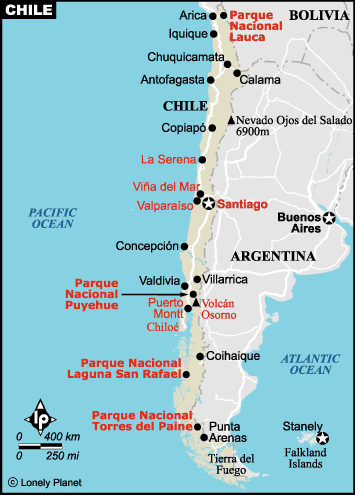| Tuesday December
24, 2002 Pucon Chile We are in Pucon, Chile for
Christmas, hoping the weather will improve. We had what
could have been a very scenic drive over the Andes from
Argentina, but the clouds were hanging low over the
mountains and it was blowing and drizzly. Nevertheless,
the Andes are spectacular. We like them so much we have
been hanging around them in both Argentina and Chile.
The last you heard from us we
were about to leave Argentina and board the bus for
Puerto Natales, Chile, in anticipation of hiking in the
Torres Del Paine National Park. Puerto Natales is not the
sort of town I would go out of my way to visit, but it is
the gateway to the Torres Del Paine, so everyone ends up
there. It is a rather dusty, scruffy town set on an ocean
inlet with beautiful mountains in the background. But it
is quiet and friendly, so we didn´t mind spending
several days there waiting to start our hike. It also
gave me more time to recover from the cold that had me
going through an awful lot of Kleenex (actually, we use
all-purpose toilet paper).
Our first night in town we caught the last day of the
travelling version of the Banff Film Festival. The theme
was Mountain Madness. We watched a number of short films
from several countries depicting an ascent of Fitz Roy
mountain in Argentina and jumping off mountain tops with
parachutes, among other wild activities. I am not
attempting any of the exploits filmed.
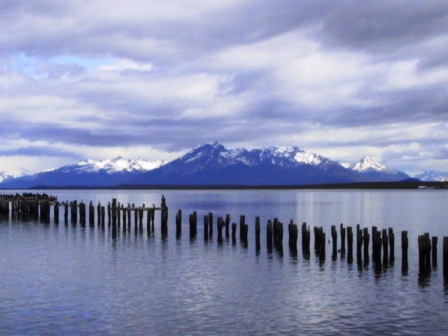
view from old dock in Puerto Natales |
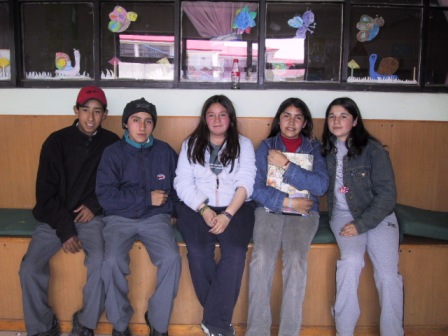
Students learning English in Puerto
Natales |
A young man, a teacher in Puerto Natales and a friend
of our landlady, arrived at our hostel one morning to ask
if Ray or I would consider helping him with his English
class. He was substituting for the regular teacher who
was ill. The class was due
to take an oral test and they needed an English speaking
person to help. I said I would, so that afternoon found
me answering questions from a small group of 14 and 15
year olds. Their English was still in the rudimentary
stage so I got to ask them questions when they ran out of
their stock four or five questions. They seemed pleased
with the results and so was I. Like most teenagers, they
like sports and pop music, but since there is no movie
house in town, they are not up on the Hollywood scene.

Refugio Pehoe where we stayed
overnight on our walk |
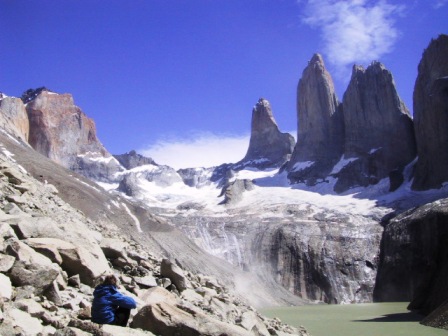
first great view of Torres del Paine
(tower peaks) |
There
are two types of accommodation when you hike the Torres
Del Paine; you can take your own tent and cooking
equipment, or you can stay in the refugios (huts). You
can also spend eight days hiking the whole circuit of the
Torres, or you can spend four or five days hiking the ´W´
to see the most popular areas. We wanted to limit the
weight we would carry during our hike so we opted for the
refugio route and four days sounded about right. The
refugios are very popular and are not very big, so we had
to wait three days for reservations before starting our
hike.
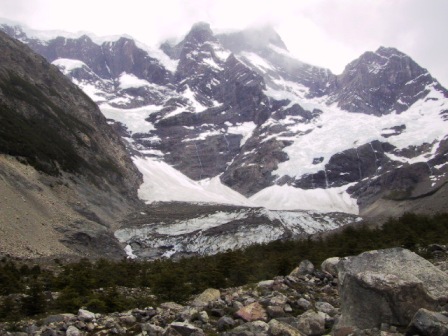
Glacier in Vallee Frances on
route |
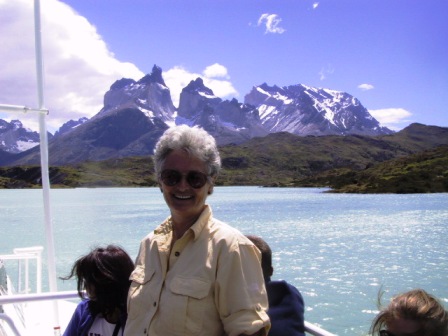
Torres Del Paine view from boat |
Actually Ray was so insensed with the high price and
the two tiered pricing system set by the private company
that owns three of the Refugios, he almost said forget it.
You
pay US$17 per night, for just a bunk bed with a mattress
but no pillow or blankets. If you pay in Chilean Pesos,
you are charged 18% more. You can also buy all your meals
at equally high rates or you can bring your own food and
use their kitchens to cook. We decided to go regardless,
but we brought our own food for all but one dinner. The scenery was spectacular and although
we had long days on the trail, we were sad to leave the
area. We saw soaring pillars of rock towering above
glacial lakes, rushing brooks and waterfalls and glaciers
on every peak. Despite the number of people in the area,
there was never a congestion problem. We might pass
people going the opposite direction, or occasionally we
were passed by faster hikers, but usually we found
ourselves alone on the trails. If I had it to do over
again, I would stay five days, but I would buy all my
dinners. The one we did have was quite good and it sure
did beat our own pasta dinners.
After finishing our hike in Torres Del Paine, we
returned to Puerto Natales and the next day, took the bus
to Punta Arenas, a little farther south, where we got a
flight north to Peuto Montt. We chose the plane ride over
a four day boat trip up the coast and we are happy we did.
The boat trip can be fun if the weather cooperates, but a
short plane ride had more appeal than four days on a
rocking boat. We made sure we had seats on the right side
of the plane so that we could see all the Andes,
including some of the mountains we had hiked.

Osorno Volcano in Puerto Montt |
We had decided that we would take a bus from Puerto
Montt back
across the Andes to Bariloche, Argentina, so we only
stayed in Puerto Montt one day. We made the most of that
day by taking a minibus tour of some of the surrounding
lakes and snow covered volcanoes. Puerto Montt is a busy
commercial center on an ocean inlet and is a gateway to
the Chilean Lake District. This is a favourite vacation
spot for Chileans who stay in one of the many hotels in
the area or own cottages around the beautiful lakes.
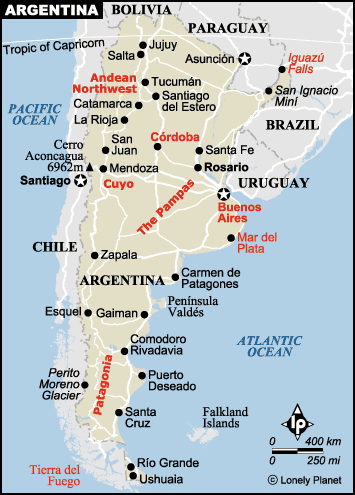
Click
the map above
to see an album of photos of Bariloche and San Martin. Close the
window to return to this page. |
Bariloche was worth the trip. It is built on
the steep slopes of the hills at one end of the 100 Km
long glacial Lago Nahuel Huapi. Bariloche is a large
resort town styled like a Swiss Alpine village. There is
even a stone clocktower on the town hall and a triple
arched stone gateway to the main town plaza. Most of the
hotels and stores have retained this alpine style,
resulting in a busy but very pretty town.
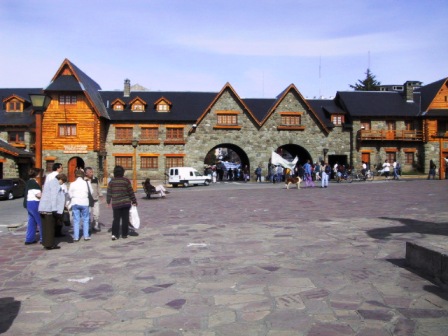
Bariloche Town Square |

Clock Tower in town square |
We stayed in a friendly hostel in the main town and
explored many of the walks in the area. Several of our
fellow hostelers were off on multi-day excursions to the
mountains in the area, staying in refugios along the way,
but we opted for tamer hiking. One day we took the local
bus 26 Km around the lake to visit Cerro (peak) Llao Llao
(pronounced sh-ow sh-ow). The bus lets you off at the
plush Hotel Llao Llao on the top of a hill overlooking
the lake and their golf course. It was very impressive
and could rival any of the better North American resorts.
An English couple staying at our hostel were so impressed
that they inquired about staying there for a few days.
The cost at US$208 per night for a standard room with a
view of the lake wasn´t too bad, but it was booked solid.
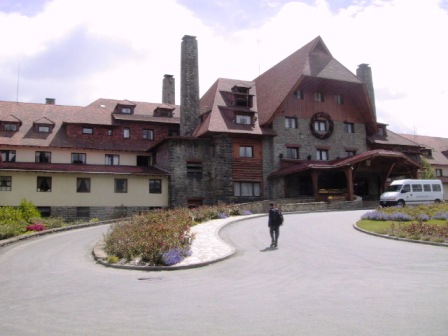
Hotel Llao Llao |

Lago Nahuel Huapi |
We settled for an hour hike through the woods to a
rocky peak, Cerro
Llao Llao, where we had a great view of the snowy peaks
surrounding the lake. We tried a little bushwhacking in
our attempt to find a different trail down from the peak,
but we had to give up part way. The bamboo that grows in
the area makes bushwhacking a challenge and we really had
no idea where we were heading.
Bariloche is also a ski center in the winter, so we
set out another day to walk to a viewpoint at the top of
one of the gondola lifts. Most of the way was along the
same steep, gravel road used by the cars to access the
lifts in the winter, but of course we didn´t stop there.
We found a trail leading further up to Cerro Otto so that
we could get a 360 degree view of the area. We had to
shelter from the fierce wind behind some rocks to enjoy
the view, but it was worth it. The mountains stretch out
for miles in every direction.
We
stopped at a refugio cum tea house on the way down to get
warmed up with a hot cuppa. The refugio, still in use,
was filled with memorabilia of Otto Meiling, for whom
Cerro Otto was named. He was a German skier and
mountaineer who settled in the area in 1930 and was
responsible for bringing alpine sports to Bariloche.

Inside Refugio Berhof |

San Martin de los Andes on Lago Lacar |
We took the bus through the scenic Seven Lakes to our
next stop, San Martin de Los Andes, another lovely alpine
style town with lots of hiking possibilities, nestled in
the hills at one end of long, thin Lago Lacar. We
climbed up to the popular Bandurria Lookout for the view
down the lake then took a different route back to town
over a long gravel road. Ray wants you to know that I
declined the offer to bushwhack straight up the
mountainside in the hopes of reaching another lookout. I
was leery after our Llao Llao experience.

Cerro Colorado |
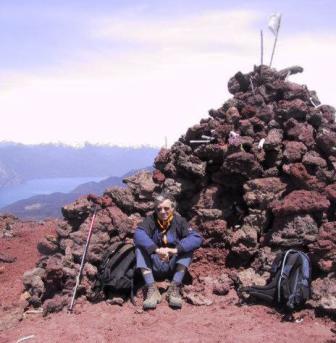
Cairn on Cerro Colorado |
Our last day in San Martin, in my opinion, we hit the
jackpot for hikes in the area. We took a taxi 10 Km out
of town and then followed a trail to Cerro Colorado. It had
been offered as a guided walk but we figured we could do
it on our own and we were right. It was an 1½ hour grunt
straight up the hill to a rocky promontory, but we had
great views of Lake Lacar and more of those snowy peaks.
At first glance, we thought we were at the top, but we
saw the trail continuing upward, so on we went. By that
point we were above the tree line and the wind had picked
up, so on went our raincoats. The
top section changed to red lava rock and ended in a
Nepali rock cairn complete with a prayer flag and
religious figure in the center of the cairn. The view was
magnificent. The skies were still relatively blue and we
could see the 3776 M high Volcan Lanin on the Argentine/Chile
border as well as another unknown volcano even farther
away. We huddled behind the rock cairn to have our lunch
and enjoy the view, then we hustled down the hill to
await the return of our taxi driver. Hitching a ride home
didn´t seem like a very good option as the cars were few
and far between on that road.
Christmas Eve we boarded another bus to cross the
Andes once again and returned to Chile. We had reserved
seats, but the bus was packed with families going to
visit their relatives for the holiday. We have crossed
the Argentine/Chile border several times now and we know
what to expect, but this was the longest border crossing
yet. At the last town before the border, there was a
delay while everyone´s passport or other identity was
checked and forms were filled out to be handed in at the
border. Next came the leaving ceremony at the Argentine
border. Everyone had to file out of the bus and stand in
line until their name was called and we were stamped out
of the country. Back on the bus, we travelled about 10 Km
to the Chile border crossing. Once again everyone had to
get out of the bus and file inside to be processed. We
knew that Chile was vigilant about imports of fruits,
vegetables or meat products so we had eaten our fruit
before reaching the border. What we hadn´t counted on
was that this was the day that everyone´s luggage was
inspected. All the bags were taken off the bus and
everyone had to claim their bag and present it to a
customs officer. They were opening every bag and
rummaging through looking for heaven knows what. Ray got
caught. He had a left over garlic clove that got
confiscated. I hope the customs officers can boast that
they stopped a garlic invasion in Chile. Finally we were
allowed back on our bus to complete the journey. It took
6 ½ hours to make the 173 Km journey. Granted, most of
the route was unpaved and was a narrow twisty road over
the Andes, but it was a slow trip. It was a good thing
everyone was in a good mood.
The clouds are low over the mountains today and it has
been raining off and on all day. Not a particularly good
start for Christmas. We are hoping the weather improves
so we can join a group to climb a volcano near town.
There are also white water rafting possibilities, so even
if it is not great weather, we can keep ourselves amused.
From Pucon, we plan to keep going north, first to
Santiago, then Valparaiso on the coast, then up to the
border with Bolivia. I must say that neither Argentina
nor Chile are third world countries. They are easy to
travel in and even though there are lots of unpaved roads
and there are some poor areas, the water is drinkable and
the scenery is great. Much of what we have done so far is
similar to our New Zealand outdoor adventures, but that
is just fine with us. Our encounters with third world
cultures will come soon enough in Bolivia, Peru and
Ecuador. We look forward to those adventures.
|
